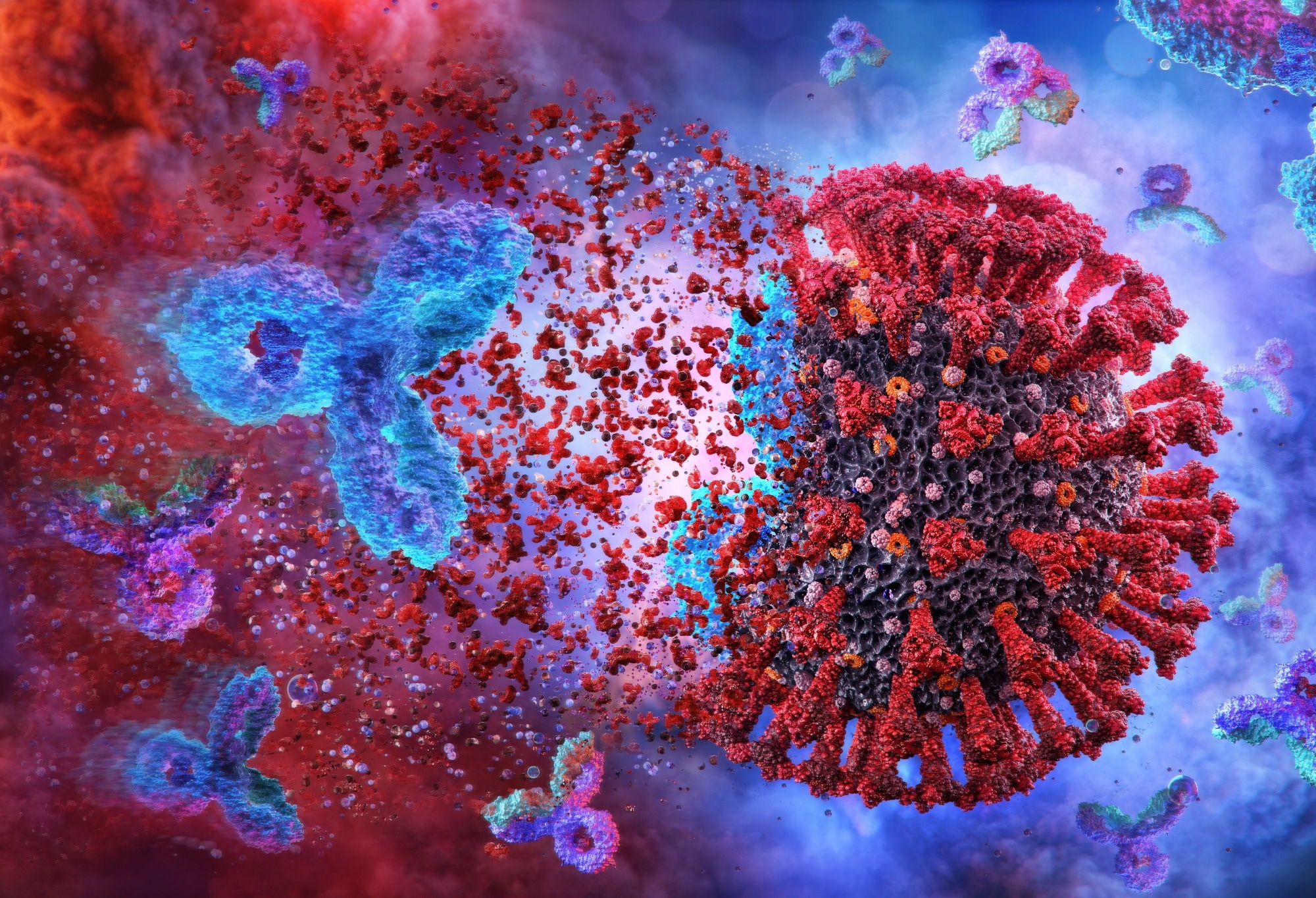In a recent study published in Cell Reports, researchers generated and characterized two monoclonal antibodies (NA8 and NE12) that target the receptor binding domain of the severe acute respiratory syndrome coronavirus 2 (SARS-CoV-2) spike protein and exhibit neutralizing activity against major SARS-CoV-2 variants of concern.
 Study: Potent monoclonal antibodies neutralize Omicron sublineages and other SARS-CoV-2 variants. Image Credit: Corona Borealis Studio/Shutterstock
Study: Potent monoclonal antibodies neutralize Omicron sublineages and other SARS-CoV-2 variants. Image Credit: Corona Borealis Studio/Shutterstock
Background
Although the rapid development of vaccines and monoclonal antibody therapies have limited the morbidity and mortality associated with the coronavirus disease 2019 (COVID-19) pandemic, the emergence and global dominance of the SARS-CoV-2 Omicron subvariants carrying mutations that enable immune evasion is a growing cause for concern.
The SARS-CoV-2 Omicron (BA.1) variant contains 30 mutations in the spike protein region, 15 of which are in the receptor binding domain, which is the region most neutralizing antibodies target. Subvariants BA.4 and BA.5 have replaced the other variants in global dominance and exhibit resistance against neutralizing antibodies elicited from vaccines and previous SARS-CoV-2 infections.
Current therapeutic monoclonal antibodies also exhibit reduced efficacy against these subvariants, highlighting the need for more effective antibody therapies to tackle the emergent Omicron subvariants.
About the study
In the present study, the researchers used ribonucleic acid (RNA) extracted from the peripheral blood mononuclear cells (PBMC) of 12 COVID-19 patients with high titers of neutralizing antibodies against SARS-CoV-2 to construct the phage-display fragment antigen-binding (Fab) libraries.
Enzyme-linked immunosorbent assays (ELISA) were used to screen for clones that bound specifically to the trimeric spike protein. Deoxyribonucleic acid (DNA) sequencing was used to identify clones with distinct sequences, which were then expressed as soluble Fabs and complete immunoglobulin G1 (IgG1) antibodies. The binding affinity of the IgG antibodies was tested using ELISA, while surface plasmon resonance was used to test the binding affinity of the Fabs towards the trimeric spike protein.
Neutralization assays using pseudotyped viruses were performed to evaluate the selected monoclonal antibodies. The specificity of the monoclonal antibodies towards the receptor binding domain of the spike protein was tested using competition ELISA. The study also tested the neutralizing ability of the monoclonal antibodies against WA-1, the North American founder strain, and other relevant variants of concern. Furthermore, the neutralizing ability of the selected monoclonal antibodies was compared against that of monoclonal antibodies in clinical use.
Cryogenic electron microscopy (cryo-EM) was used to understand the structural interactions between the SARS-CoV-2 spike protein trimer and the two most potent monoclonal antibodies from the study — NA8 and NE12.
Additionally, hamster models were used to test the in vivo prophylactic efficiency and therapeutic activity of NA8 and NE12. For testing the prophylactic efficacy, the hamsters were intraperitoneally inoculated with different concentrations of the monoclonal antibodies before being intranasally challenged with the Beta variant and WA-1 strain of SARS-CoV-2. The therapeutic efficacy was measured by intraperitoneally administering the hamsters with monoclonal antibodies after infecting them with the WA-1 strain and Beta variant.
Results
The results reported that NA8 and NE12 have complementary properties, and exhibited potent neutralizing action against all the major SARS-CoV-2 variants of concern. The NA8 monoclonal antibody displayed broad neutralizing abilities at picomolar concentrations against the Beta variant and Omicron BA.1 and BA.2 subvariants, and at nanomolar concentrations against the recent BA.2.12.1 and BA.4 subvariants.
The cryo-EM structural analysis images revealed that the NA8 antibody has a highly conserved binding epitope with a slightly shifted receptor binding ridge which allows it to circumvent the mutated regions of the Beta and Omicron receptor binding regions. The NE12 epitope was seen to overlap the angiotensin-converting enzyme-2 (ACE-2) receptor footprints of the receptor binding domain. Despite having partially overlapping epitopes, the combined use of NA8 and NE12 did not display any reduction in the neutralizing potency of either of the monoclonal antibodies.
The two monoclonal antibodies also displayed high prophylactic and therapeutic potency in vivo, when tested in hamster models. Furthermore, compared to current monoclonal antibodies in clinical use, NA8 and NE12 exhibited potent and broad neutralizing action.
Conclusions
To summarize, the study reported the development and characterization of novel monoclonal antibodies NA8 and NE12 that displayed broad and potent neutralizing abilities against the major SARS-CoV-2 variants and the currently dominant Omicron subvariants when used in combination.
The two monoclonal antibodies also exhibited high therapeutic and prophylactic action in vivo in hamster models. Structural analysis of the binding epitopes explained the broad potency and reactivity. The conserved binding epitope of NA8 also indicates its ability to neutralize future variants.
With currently used monoclonal antibody therapies and vaccines losing efficacy against the emergent Omicron subvariants, the development of broadly neutralizing antibodies such as NA8 and NE12 can help limit the global spread of immune-evading SARS-CoV-2 variants.